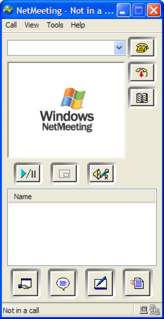
Windows Messenger is a discontinued instant messaging client included in Windows XP. Designed for use by both corporate and home users, it was originally created, in 2001, as a streamlined and integrated version of MSN Messenger. It was upgraded several times when it was made available for Windows 2000 and Windows Server 2003. Since then, its development stopped. It was superseded by Windows Live Messenger and Microsoft Lync.

Miranda IM is an open-source multiprotocol instant messaging application, designed for Microsoft Windows. Miranda is free software distributed under the GNU GPL-2.0-or-later.
Trident is a proprietary browser engine for the Microsoft Windows version of Internet Explorer, developed by Microsoft.

Microsoft NetMeeting is a discontinued VoIP and multi-point videoconferencing client included in many versions of Microsoft Windows. It uses the H.323 protocol for videoconferencing, and is interoperable with OpenH323-based clients such as Ekiga, OpenH323, and Internet Locator Service (ILS) as reflector. It also uses a slightly modified version of the T.120 Protocol for whiteboarding, application sharing, and file transfers.

Skype for Business was an enterprise software application for instant messaging and videotelephony developed by Microsoft as part of the Microsoft Office suite. It is designed for use with the on-premises Skype for Business Server software, and a software as a service version offered as part of Office 365. It supports text, audio, and video chat, and integrates with Microsoft Office components such as Exchange and SharePoint.
Microsoft Notification Protocol is an instant messaging protocol developed by Microsoft for use by the Microsoft Messenger service and the instant messaging clients that connect to it, such as Skype since 2014, and the earlier Windows Live Messenger, MSN Messenger, Windows Messenger, and Microsoft Messenger for Mac. Third-party clients such as Pidgin and Trillian can also communicate using the protocol. MSNP was first used in a publicly available product with the first release of MSN Messenger in 1999.

Windows Live is a discontinued brand-name for a set of web services and software products from Microsoft as part of its software plus services platform. Chief components under the brand name included web services, several computer programs that interact with the services, and specialized web services for mobile devices.

Windows Meeting Space was a peer-to-peer collaboration program developed by Microsoft for Windows Vista as a replacement for Windows NetMeeting and it enables application sharing, collaborative editing, desktop sharing, file sharing, projecting, and simple text-based or ink-based instant messaging across up to 10 users connected to the same network or across the Internet. Meeting Space has the ability to automatically set up an ad hoc wireless network if a connection to a network or the Internet are not available and also enables participants to invite other people to meeting sessions. It is the first application for the new peer-to-peer framework in Windows Vista and hence requires IPv6.

Windows Live Mesh is a free-to-use Internet-based file synchronization application by Microsoft designed to allow files and folders between two or more computers to be in sync with each other on Windows and Mac OS X computers or the Web via SkyDrive. Windows Live Mesh also enabled remote desktop access via the Internet.

Messenger Plus! is an add-on for Windows Live Messenger and Skype. The software provides additional functionality to Microsoft's Instant messaging client, Windows Live Messenger, by adding its own controls to the main interface. These controls affect Messenger's behaviour and appearance, often through additional dialog boxes.

Windows Essentials is a discontinued suite of Microsoft freeware applications that includes email, instant messaging, photo sharing, blogging, and parental control software. Essentials programs are designed to integrate well with each other, with Microsoft Windows, and other Microsoft web-based services such as OneDrive and Outlook.com.

Live Connect is a collection of APIs and common controls that allow developers to have a deeper control and offers access to the core Windows Live services and data through open and easily accessible application programming interfaces (APIs). At MIX07, Microsoft's Senior Architect Danny Thorpe described:
[The Windows Live Platform] today can combine video, photos, contacts, maps, and search into web applications. Users can drop web controls into the web applications with just a few lines of JavaScript and be up and running in a matter of minutes, and they can dive a little deeper to access service APIs directly and define their own UI and process flow. Users have control over what applications can access their private data, and can revoke that access at any time.

Windows Contacts is a contact manager that is included in Windows Vista, Windows 7, Windows 8, Windows 10, and Windows 11. It replaced but retains most of the functionality of Windows Address Book and worked with Windows Live Mail and the Vista version of Windows Mail.

Microsoft OneDrive is a file hosting service and synchronization service operated by Microsoft as part of its web version of Office. First launched in August 2007, OneDrive allows users to store files and personal data like Windows settings or BitLocker recovery keys in the cloud, share files, and sync files across Android, Windows Phone, and iOS mobile devices, Windows and macOS computers, and the Xbox 360, Xbox One, and Xbox Series X and S consoles. Users can upload Microsoft Office documents to OneDrive.

Windows Live Web Messenger was the browser-based version of Windows Live Messenger developed by Microsoft which allowed users to send instant messages online and in real-time with others using the Microsoft Messenger service from within a web browser. The service allowed users without administrative privileges on their computer, such as at a shared public computer, to chat with others on their Messenger contact list without having to install the Windows Live Messenger client.

Outlook.com is a personal information manager web app from Microsoft consisting of webmail, calendaring, contacts, and tasks services. Founded in 1996 by Sabeer Bhatia and Jack Smith as Hotmail, it was acquired by Microsoft in 1997 for an estimated $400 million and relaunched as MSN Hotmail, later rebranded to Windows Live Hotmail as part of the Windows Live suite of products. Microsoft phased out Hotmail in October 2011, relaunching the service as Outlook.com in 2012.

Windows Live Video Messages was a Windows Live service by Microsoft. It combined digital video with e-mail into a service that allows all webcam users to create, send, and receive video messages to anyone in their Windows Live Contacts list, even when they are offline. The service also provided a Windows Sidebar gadget for Microsoft LifeCam users that allows them to access their top six contacts and essential Video Messages features directly from their desktop.

MSN Messenger, later rebranded as Windows Live Messenger, was a cross-platform instant messaging client developed by Microsoft. It connected to the Microsoft Messenger service while also having compatibility with Yahoo! Messenger and Facebook Messenger. The client was first released as MSN Messenger Service on July 22, 1999, and was marketed under the MSN branding until 2005 when it was rebranded under Windows Live. It has since been officially known by its second name, although its first name was still used colloquially by most of its users. In June 2009, Microsoft reported the service attracted over 330 million active users each month, placing Messenger among the most widely used instant messaging clients in the world.

aMSN is a free Windows Live Messenger clone. aMSN attempts to emulate the look and feel of Windows Live Messenger, and supports many of its features. It has been downloaded approximately 40 million times as of January 2011, making it the 21st most downloaded project on SourceForge.
Slenfbot is the classification for a family of malicious software (malware), which infects files on Microsoft Windows systems. Slenfbot was first discovered in 2007 and, since then, numerous variants have followed; each with slightly different characteristics and new additions to the worm's payload, such as the ability to provide the attacker with unauthorized access to the compromised host. Slenfbot primarily spreads by luring users to follow links to websites, which contain a malicious payload. Slenfbot propagates via instant messaging applications, removable drives and/or the local network via network shares. The code for Slenfbot appears to be closely managed, which may provide attribution to a single group and/or indicate that a large portion of the code is shared amongst multiple groups. The inclusion of other malware families and variants as well as its own continuous evolution, makes Slenfbot a highly effective downloader with a propensity to cause even more damage to compromised systems.













